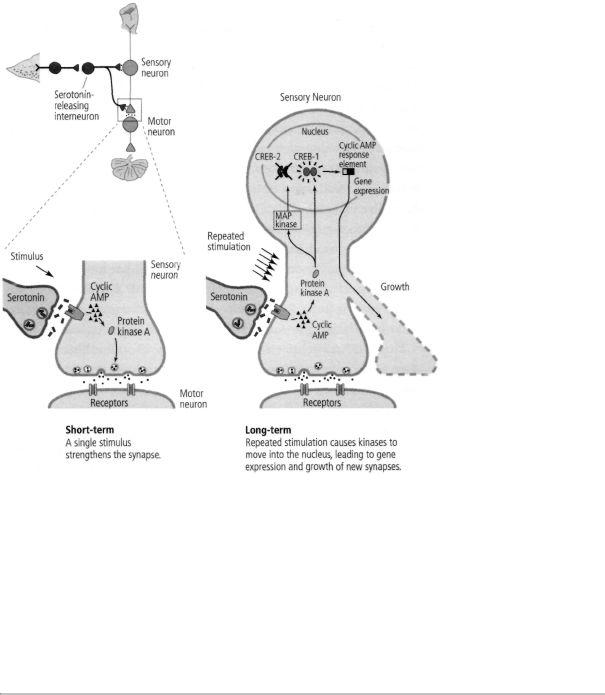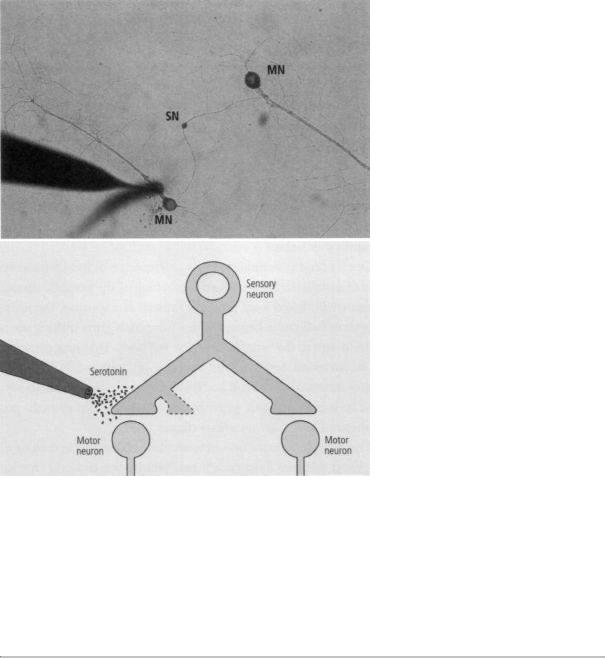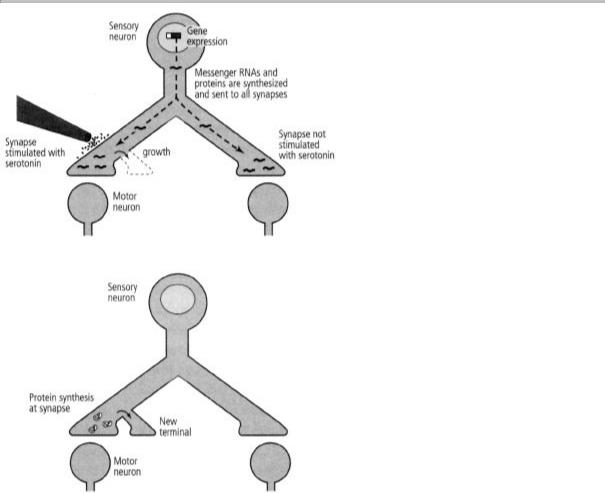
Erik_Kandel_-_V_poiskakh_pamyati_angl
.pdf
Jacob and Monod inferred what we now know to be a fact: that even in a complex organism like a human being, almost every gene of the genome is present in every cell of the body. Every cell has in its nucleus all of the chromosomes of the organism and therefore all of the genes necessary to form the entire organism. This inference raised a serious question for biology: Why do not all genes function in the same way in every cell of the body? Jacob and Monod proposed what ultimately proved to be the case—namely that a liver cell is a liver cell, and a brain cell is a brain cell because in each cell type only some of those genes are turned on, or expressed; all of the other genes are shut off, or repressed. Thus, each cell type contains a unique mix of proteins—a subpopulation of all the proteins available to the cell. This mix of proteins enables the cell to perform its specific biological functions.
Genes are switched on and off as needed to achieve optimal functioning of the cell. Some genes are repressed for most of the lifetime of the organism; other genes, such as those involved in the production of energy, are always expressed because the proteins they encode are essential for survival. But in every cell type some genes are expressed only at certain times, whereas others are turned on and off in response to signals from within the body or from the environment. This set of arguments caused a lightbulb to go on in my brain one night: What is learning but a set of sensory signals from the environment, with different forms of learning resulting from different types or patterns of sensory signals?
What sort of signals regulate the activity of genes? Just how are genes turned on and off? Jacob and Monod found that in bacteria, genes are switched on and off by other genes. This led them to distinguish between effector genes and regulatory genes. Effector genes encode effector proteins such as enzymes and ion channels, which mediate specific cellular functions. Regulatory genes encode proteins called gene regulatory proteins, which switch the effector genes on or off. Jacob and Monod then asked: How do the proteins of the regulatory genes act on the effector genes? They postulated that every effector gene has in its DNA not only a coding region that encodes a particular protein but also a control region, a specific site now known as the promoter. Regulatory proteins bind to the promoter of effector
sites and thereby determine whether the effector genes are going to be switched on or off.
Before an effector gene can be switched on, regulatory proteins must assemble on its promoter and help to separate the two strands of DNA. One of the exposed strands is then copied into messenger RNA in a process known as transcription. Messenger RNA carries the gene's instructions for protein synthesis from the nucleus of the cell to the cytoplasm, where structures known as ribosomes translate the messenger RNA into protein. Once the gene has been expressed, the two strands of DNA zip up again, and the gene is shut off until the next time regulatory proteins initiate transcription.
Jacob and Monod not only outlined a theory of gene regulation, they also discovered the first regulators of gene transcription. These regulators come in two forms—repressors, genes that encode the regulatory proteins that shut genes off, and as later work showed, activators, genes that encode the regulatory proteins that turn genes on. Through brilliant reasoning and insightful genetic experiments, Jacob and Monod found that when the common intestinal bacterium E. coli has a plentiful supply of a food source, the sugar lactose, the bacterium turns on a gene for an enzyme that breaks down lactose for consumption. When no lactose is present, the gene for this digestive enzyme is suddenly turned off. How does this occur?
The two scientists found that in the absence of lactose, the repressor gene encodes a protein that binds to the promoter of the gene for the digestive enzyme, thereby preventing the gene's DNA from being transcribed. When they reintroduced lactose into the medium in which the bacteria were grown, the lactose moved into the cell and bound to the repressor proteins, causing them to fall off the promoter. The promoter was then free to bind proteins encoded by an activator gene. The activator proteins turn the effector gene on, resulting in production of the enzyme that metabolizes lactose.

These studies showed that E. coli adjusts the rate of transcription of particular genes in response to environmental cues. Later studies revealed that when a bacterium finds itself in the presence of a low concentration of glucose, it responds by synthesizing cyclic AMP,
which sets off a process that enables the cell to consume an alternative sugar.
The finding that gene function can be regulated up and down in response to environmental needs by signaling molecules from outside the cell (such as different sugars) as well as from inside the cell (second messenger signals such as cyclic AMP) was revolutionary to me. It caused me to rephrase in molecular terms the question of how short-term memory is converted to long-term memory. I now asked: What is the nature of the regulatory genes that respond to a specific form of learning, that is, to cues from the environment? And how do these regulatory genes switch a short-term synaptic change that is critical to a specific short-term memory into a long-term synaptic change that is critical to a specific long-term memory?
Our studies in invertebrates, as well as several studies in vertebrates, had demonstrated that long-term memory requires the synthesis of new protein, indicating that the mechanisms of memory storage are likely to be quite similar in all animals. Moreover, Craig Bailey had made the remarkable discovery that long-term memory in Aplysia endures because sensory neurons grow new axon terminals that strengthen their synaptic connections with motor neurons. Yet exactly what it takes to throw the switch for any form of long-term memory remained a mystery. Does the pattern of learning that produces long-term sensitization activate certain regulatory genes, and do the proteins encoded by those genes prompt effector genes to direct the formation of new axon terminals?
By studying living sensory and motor cells in culture we had reduced our behavioral system sufficiently to address these questions. We had located a critical component of long-term memory in the synaptic connection between only two cells. Now we could use the techniques of recombinant DNA to ask: Do regulatory genes switch on and maintain long-term strengthening of this connection?
AT ABOUT THIS TIME, I BEGAN TO RECEIVE FORMAL RECOGNITION
for my work. In 1983 I shared with Vernon Mountcastle the Lasker Award in basic medical sciences, the most important scientific recog-
nition awarded in the United States, and I received my first honorary degree, from the Jewish Theological Seminary in New York. I was thrilled that they would even know of my work. I suspect they learned of it from my colleague Mortimer Ostow, one of the psychoanalysts who first stirred my interest in psychoanalysis and the brain.
My father had died by then, but my mother came to the graduation ceremony and, in his introductory remarks, Gerson D. Cohen, the chancellor of the seminary, referred to my having received a good Hebrew education at the Yeshivah of Flatbush, an acknowledgment that filled my mother's Jewish heart with pride. I think the recognition that her father, my grandfather, had tutored me well in Hebrew may have meant more to her than the distinction of the Lasker Award a few months later.
19

A DIALOGUE BETWEEN GENES AND SYNAPSES
In 1985 I finally began to apply the insights I had gained from night science—from months of thinking about the proteins that regulate gene expression—to a daytime framework for working on gene expression and long-term memory This thinking had become more focused with the arrival at Columbia of Philip Goelet, a postdoctoral student who had trained with Sydney Brenner at the Medical Research Council Laboratory in Cambridge, England. Goelet and I reasoned as follows: longterm memory requires that new information be encoded and then consolidated, put into more permanent storage. With the finding that long-term memory requires the growth of new synaptic connections, we had gained some insight into what form this more permanent storage took. But we still did not understand the intervening molecular genetic steps—the nature of memory consolidation. How is a fleeting short-term memory converted to a stable long-term memory?
In the Jacob-Monod model, signals from a cell's environment activate gene regulatory proteins that switch on the genes encoding particular proteins. This led Goelet and me to wonder whether the crucial step in switching on long-term memory in sensitization might involve similar signals and similar gene regulatory proteins. We wondered if the
repeated learning trials required for sensitization are important because they send signals to the nucleus, telling it to activate regulatory genes that encode regulatory proteins that in turn switch on the effector genes needed for the growth of new synaptic connections. If so, the consolidation phase of memory might be the interval during which the regulatory proteins switch on effector genes. Our thinking would provide a genetic explanation for the finding that blocking the synthesis of new protein during a critical period—that is, during and shortly after learning— blocks both the growth of new synaptic connections and the conversion from shortto long-term memory. In blocking protein synthesis, we reasoned, we were actually preventing the expression of the genes that initiate protein synthesis essential for synaptic growth and long-term memory storage.
We summarized our views in "The Long and Short of Long-Term Memory," a conceptual review published in 1986 in Nature. In this paper, we proposed that if gene expression was required to convert short-term memory at a synapse into long-term memory, then the synapse stimulated by learning somehow had to send a signal to the nucleus telling it to turn on certain regulatory genes. In short-term memory, synapses use cyclic AMP and protein kinase A inside the cell to call for the release of more neurotransmitter. Goelet and I hypothesized that in long-term memory this kinase moves from the synapse to the nucleus, where it somehow activates proteins that regulate gene expression.
To test our hypothesis, we would have to identify the signal sent from the synapse to the nucleus, find the regulatory genes activated by the signal, and then identify the effector genes switched on by the regulator—that is, the genes responsible for the new synaptic growth underlying long-term memory storage.
THE SIMPLIFIED NEURAL CIRCUIT WE HAD CREATED IN TISSUE
culture—a single sensory neuron connected to a single motor neuron—gave us a complete biological system in which to test these ideas. In our culture dish, serotonin acted as an arousal signal initiated by sensitization. One pulse—the equivalent of one shock, one training trial—alerted the cell that a stimulus was of momentary short-term interest, while five pulses—the equivalent of five training

trials—signaled a stimulus of lasting, long-term interest. We found that injecting a high concentration of cyclic AMP into a sensory neuron produced not only a short-term but also a long-term increase in the strength of the synapse. We now collaborated with Roger Tsien at the University of California, San Diego and used a method developed by him that allowed us to visualize the location of the cyclic AMP and protein kinase A in the neuron. We found that whereas a single pulse of serotonin increases cyclic AMP and protein kinase A primarily at the synapse, repeated pulses of serotonin produce even higher concentrations of cyclic AMP, causing protein kinase A to move into the nucleus, where it activates genes. Later studies found that protein kinase A recruits another kinase, called MAP kinase, which is also associated with synaptic growth and also migrates to the nucleus. Thus we confirmed our idea that one of the functions of repeated sensitization training—why practice makes perfect— is to cause the appropriate signals in the form of kinases to move into the nucleus.
Once in the nucleus, what do these kinases do? We knew from recently published studies of non-neuronal cells that protein kinase A can activate a regulatory protein called CREB (cyclic AMP response element-binding protein), which binds to a promoter (the cyclic AMP response element). This suggested to us that CREB might be a key component of the switch that converts short-term facilitation of synaptic connections to long-term facilitation and the growth of new connections.
In 1990, joined by two postdoctoral students, Pramod Dash and Benjamin Hochner, we found that CREB is present in the sensory neurons of Aplysia and is indeed essential to the long-term strengthening of synaptic connections underlying sensitization. By blocking the action of CREB in the nucleus of a sensory neuron in culture, we prevented long-term, but not short-term, strengthening of these synaptic connections. This was astonishing: blocking this one regulatory protein blocked the entire process of long-term synaptic change! Dusan Bartsch, a creative and technically brilliant postdoctoral fellow, later found that simply injecting CREB that had been phosphorylated by protein kinase A into the nucleus of sensory neurons was sufficient to turn on the genes that produce long-term facilitation of these connections.
Thus, even though I had long been taught that the genes of the brain are the governors of behavior, the absolute masters of our fate, our work showed that, in the brain as in bacteria, genes also are servants of the environment. They are guided by events in the outside world. An environmental stimulus—a shock to an animal's tail— activates modulatory interneurons that release serotonin. The serotonin acts on the sensory neuron to increase cyclic AMP and to cause protein kinase A and MAP kinase to move to the nucleus and activate CREB. The activation of CREB, in turn, leads to the expression of genes that changes the function and the structure of the cell.
In 1995 Bartsch found that there are in fact two forms of the CREB protein, much as the model of Jacob and Monod might have predicted: one that activates gene expression (CREB-1), and one that suppresses gene expression (CREB-2). Repeated stimulation causes protein kinase A and MAP kinase to move to the nucleus, where protein kinase A activates CREB-1 and MAP kinase inactivates CREB-2. Thus long-term facilitation of synaptic connections requires not only a switching on of some genes, but also the switching off of others (figure 19-1).
As these exciting findings were emerging in the laboratory, I was struck by two things. First, we were seeing the Jacob-Monod model of gene regulation applied to the process of memory storage. Second, we were seeing Sherrington's discovery of the integrative action of the neuron carried to the level of the nucleus. I was amazed by the parallels: on the cellular level, excitatory and inhibitory synaptic signals converge on a nerve cell, while on the molecular level, one CREB regulatory protein facilitates gene expression and the other inhibits it. Together, the two CREB regulators integrate opposing actions.
Indeed, CREB's opposing regulatory actions provide a threshold for memory storage, presumably to ensure that only important, life-serving experiences are learned. Repeated shocks to the tail are a significant learning experience for an Aplysia, just as, say, practicing the piano or conjugating French verbs are to us: practice makes perfect, repetition is necessary for long-term memory. In principle, however, a highly emotional state, such as that brought about by a car crash, could bypass the normal restraints on long-term memory. In such a situation, enough MAP kinase molecules would be sent into the nucleus rapidly enough to

19-1 The molecular mechanisms of shortand long-term facilitation.
inactivate all of the CREB-2 molecules, thereby making it easy for protein kinase A to activate CREB- 1 and put the experience directly into long-term memory. This might account for so-called flashbulb memories, memories of emotionally charged events that are recalled in vivid detail—like my experience with Mitzi—as if a complete picture had been instantly and powerfully etched on the brain.
Similarly, the exceptionally good memory exhibited by some people may stem from genetic differences in CREB-2 that limit the activity of this repressor protein in relation to CREB-1. Although long-term memory typically requires repeated, spaced training with
intervals of rest, it occasionally occurs following a single exposure that is not emotionally charged. One-trial learning was particularly well developed in the famous Russian memorist S. V Shereshevski, who seemed never to forget anything he had learned following a single exposure, even after more than a decade. Usually, memorists have more restricted capabilities: they may be exceptionally good at remembering certain types of knowledge but not others. Some people have an astonishing memory for visual images, for musical scores, for chess games, for poetry, or for faces. Some Talmudic memorists from Poland can recall, from visual memory, every word on every page of the twelve volumes of the Babylonian Talmud as if that one page (out of several thousand) were in front of their eyes.
Conversely, a characteristic of age-related memory loss (benign senescent forgetfulness) is the inability to consolidate long-term memories. This defect of aging may represent not only a weakening

of the ability to activate CREB-1, but also an insufficiency of signals to remove the braking action of CREB-2 on memory consolidation.
The CREB switch for long-term memory, like the cellular mechanisms of short-term memory, proved to be the same in several species of animals, indicating that it has been conserved through evolution. In 1993 Tim Tully a behavioral geneticist working at the Cold Spring Harbor Laboratory in Long Island, New York, developed an elegant protocol for examining long-term memory of learned fear in the fly. In 1995 Tully joined forces with the molecular geneticist Jerry Yin, and together they discovered that CREB proteins are essential for long-term memory in Drosophila. As in Aplysia, CREB activators and repressors played critical roles. The CREB repressor blocked the conversion of short-term memory to long-term memory Even more fascinating, mutant flies bred to produce more copies of the CREB activator had the equivalent of flashbulb memories. A few training trials in which a specific odor was paired with a shock produced only a short-term memory of fear of the odor in normal flies, but the same number of trials led to long-term memory of fear in the mutant flies. In time, it would become clear that the same CREB switch is important for many forms of implicit memory in a variety of other species, from bees to mice to people.
Thus, by combining behavioral analysis first with cellular neural
science and then with molecular biology, we were able, collectively, to help lay the foundation of a molecular biology of elementary mental processes.
THE FACT THAT THE SWITCH FOR CONVERTING SHORT-TERM
memory to long-term memory is the same in a variety of simple animals that are learning simple tasks was heartening, confirming our belief that the core mechanisms of memory storage are conserved across different species. But it posed a considerable problem for the cell biology of neurons. A single sensory neuron has 1200 synaptic terminals and makes contact with about 25 target cells: gill motor neurons, siphon motor neurons, inking motor neurons, and excitatory and inhibitory interneurons. We had found that short-term changes occur in just some of those synapses and not others. That made sense, since a single shock to the tail or a single pulse of serotonin increases cyclic AMP locally, at a particular set of synapses. But long-lasting synaptic change requires gene transcription, which takes place in the nucleus and leads to the production of new proteins. One would expect the newly synthesized proteins to be shipped to all of the neuron's synaptic terminals. Thus, unless some special mechanism in the cell limits the changes to specific synapses, all of the neuron's synaptic terminals would be affected by long-term facilitation. If that were so, each long-term change would be stored at all the synapses of a neuron. This creates a paradox: How are long-term learning and memory processes localized to specific synapses?
Goelet and I thought about this question a great deal and outlined a scheme in our 1986 review in Nature that has become known as "synaptic marking." We hypothesized that the transient modification of a given synapse produced by short-term memory would somehow mark that synapse. Marking would allow proteins to be recognized by and stabilized at that synapse.
How the cell targets proteins to specific synapses was a question ideally suited for Kelsey Martin, an extremely gifted cell biologist who had obtained a combined M.D.-Ph.D. at Yale. After graduating from Harvard College, she and her husband joined the Peace Corps and worked in Africa. By the time they came to Columbia, they already
had a son, Ben. While she was in our laboratory, they had a daughter, Maya. Kelsey proved a special presence in the laboratory, not only doing first-class science with extraordinary skill, but also lifting all of our spirits by turning our little conference-lunchroom into a joyful kindergarten for gifted children from 4:00 to 6:00 p.m.

The tracking of protein kinase A to the nucleus and the discovery in the nucleus of the CREB regulators had led us along a molecular pathway from the synapse to the nucleus. Now we had to begin the reverse journey. Kelsey and I needed to explore, in a single sensory cell, how a stimulated synapse that is undergoing long-term structural changes differs from an unstimulated synapse. We did this by developing an elegant new cell culture system.
We grew a single sensory neuron with a branched axon that formed synaptic connections with two separate motor neurons. We simulated behavioral training as before by applying pulses of serotonin, but now we could apply them selectively to one or the other set of synaptic connections. A single pulse of serotonin applied to one set of synapses produced short-term facilitation in those synapses only, as expected. Yet five pulses of serotonin applied to one set of synapses produced long-lasting facilitation and growth of new synaptic terminals only at the stimulated synapses. This result was surprising because long-term facilitation and growth require the activation of genes by CREB, an action that takes place in the nucleus of the cell and should theoretically affect all of the cell's synapses. When Kelsey blocked the action of CREB in the nucleus of the cell, it suppressed both facilitation and growth at the stimulated synapse (figure 19-2).
This finding gave us tremendous insight into the computational power of the brain. It illustrates that even though a neuron may make one thousand or more synaptic connections with different target cells, the individual synapses can be modified independently, in long-term as well as short-term memory. The synapses' independence of long-term action gives the neuron extraordinary computational flexibility.
How does this extraordinary selectivity come about? We considered two possibilities: Do the neurons ship messenger RNA and proteins only to synapses marked for long-term memory storage? Or are messenger RNA and proteins shipped to all of the neuron's

1 pulse of serotonin |
5 pulses of serotonin |
No effects are seen |
strengthens the |
lead to the growth of |
at the unstimulated |
stimulated synapse. |
new terminals. |
synapse. |
19-2 Setup for studying the role of serotonin in synaptic change. A sensory neuron (SN in photo, above) with a branched axon forms synapses with two motor neurons (MN). Serotonin is applied to just one of the synapses. Only that synapse undergoes shortand long-term change. (Image courtesy of Kelsey Martin.)
synapses and only the marked synapses are able to utilize them for growth? We first began by testing the second hypothesis because it was easy to explore.
What makes this "marked for growth" process possible? Kelsey found that two things must occur at the marked synapse. The first is simply the activation of protein kinase A. If protein kinase A is not activated at the synapse, no facilitation occurs at all. The second is the activation of machinery that regulates local protein synthesis. This was a very surprising finding, and it made new sense out of a fascinating area of nerve cell biology that had not been fully appreciated and therefore had been largely ignored. In the early 1980s Oswald Steward, now at the University of California, Irvine, had discovered that even though the vast majority of protein synthesis takes place in the cell body of the neuron, some also occurs locally, at the synapses themselves.
Our findings now indicated that one function of local protein synthesis is to sustain the long-term strengthening of the synaptic connection. When we inhibited local protein synthesis at a synapse, the

process of long-term facilitation began and new terminals grew, making use of the proteins sent to the synapse from the cell body. That new growth could not be sustained, however, and after one day it regressed. Thus the proteins synthesized in the cell body and shipped to the terminals are sufficient to initiate synaptic growth, but to sustain that growth, proteins synthesized locally are necessary (figure 19-3).
These results opened up a new window on long-term memory. They suggested that two independent mechanisms are at work. One process initiates long-term synaptic facilitation by sending protein kinase A to the nucleus to activate CREB, thereby turning on the effector genes that encode the proteins needed for the growth of new synaptic connections. The other process perpetuates memory storage by maintaining the newly grown synaptic terminals, a mechanism that requires local protein synthesis. Thus we realized that there are separate processes for initiation and for maintenance. How does that second mechanism work?
IT WAS AT THIS POINT IN 1999 THAT KAUSIK SI, A REMARKABLY
original and effective scientist, joined the laboratory. Kausik came
19-3 Two mechanisms of long-term change. New proteins are sent to all of the synapses (above), but only synapses stimulated with serotonin use them to initiate the growth of new axon terminals. Proteins synthesized locally (below) are needed to sustain the growth initiated by gene expression.
from a small town in India, where his father taught in the local high school. When Kausiks father realized that Kausik was interested in biology, he asked a colleague, the local biology teacher, to take

the boy under his wing. This biology teacher taught Kausik a great deal and engendered his interest in genetic mechanisms. The teacher also
encouraged Kausik to seek graduate training in biology in the United States, which ultimately led to his taking his postdoctoral training with me at Columbia.
Kausik had done his Ph.D. research on protein synthesis in yeast, and after arriving at Columbia, he began to think about the problem of local protein synthesis in Aplysia. We knew that messenger RNA molecules are synthesized in the nucleus and translated into protein at specific synapses. So the question was this: Is the messenger RNA sent to the terminals in an active state? Or is it sent in a dormant state, like Sleeping Beauty waiting to be kissed at the marked synapses by some molecular Prince Charming?
Kausik favored the Sleeping Beauty hypothesis. He argued that the dormant messenger RNA molecules become activated only if they reach an appropriately marked synapse and encounter a particular signal. He pointed out that an interesting example of this sort of regulation occurs in the development of the frog. As the frog's egg becomes fertilized and matures, dormant messenger RNA molecules are awakened and activated by a novel protein that regulates local protein synthesis. This protein is known as CPEB (cytoplasmic polyadenylation element-binding protein).
As we journeyed deeper into the maze of molecular processes underlying memory, Kausik found that a novel form of CPEB in Aplysia was indeed the Prince Charming we had sought. The molecule is present only in the nervous system, is located at all the synapses of a neuron, is activated by serotonin, and is required at the activated synapses to maintain protein synthesis and the growth of new synaptic terminals. But Kausik's finding advanced the question just one step further. Most proteins are degraded and destroyed in a period of hours. What maintains growth over longer periods of time? What, in principle, has sustained my memory of Mitzi for a lifetime?
As Kausik looked carefully at the amino acid sequence of the novel CPEB, he noticed something very peculiar. One end of the protein had all the characteristics of a prion.
Prions are probably the weirdest proteins known to modern biology. They were first discovered by Stanley Prusiner of the University of California, San Francisco as the causal agents of several mysterious
neurodegenerative diseases, such as mad cow disease (bovine spongiform encephalopathy) in cattle and Creutzfeldt-Jakob disease in people (this is the disease that tragically killed Irving Kupfermann in 2002, at the prime of his scientific career). Prions differ from other proteins in that they can fold into two functionally distinct shapes, or conformations; one of these is dominant, the other recessive. The genes that encode prions give rise to the recessive form, but the recessive form can be converted to the dominant form, either by chance alone, as may have happened with Irving, or by eating food that contains an active form of the protein. In the dominant form, prions can be lethal to other cells. The second way in which prions differ from other proteins is that the dominant form is self-perpetuating; it causes the recessive conformation to change its shape and thereby become dominant and self-perpetuating as well (figure 19-4).
I remember it was a beautiful New York afternoon in the spring of 2001, the bright sunlight rippling off the Hudson River outside my office windows, when Kausik walked into my office and asked, "What would you say if I told you that the CPEB has prion-like properties?"
